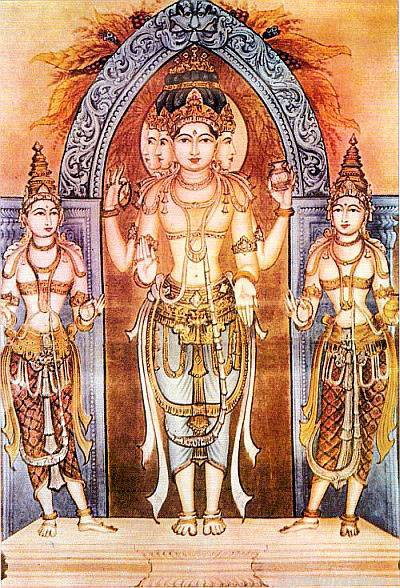
|
|
|
|
Unless there is a hidden Brahmadeva temple in the Kottakkal area that we have not identified, it seems very likely that the temple being referred to on the lists of Brahma temples is the only temple in the general area that is actually dedicated to Lord Brahma – the one in Thirunavaya, on the banks of the Bharathapuzha River.
Probably the most famous and often visited site in all of Kottakkal is the Arya Vaidya Sala Ayurvedic Research Center and Hospital. Known worldwide for its excellence in Ayurvedic healing and on-site production of medicinal preparations, every travelogue on Kottakkal makes mention of this place.
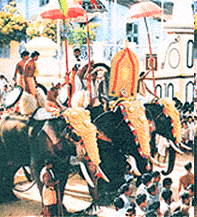
Temple architecture typical of Trivandrum Often mentioned in regard to the Ayurvedic center is the large Poornam festival they sponsor each year, which is dedicated to Lord Dattatreya. Large crowds gather to enjoy performances by masters of music, art, culture and literature, who arrive here from all over India to participate in the mela. The Kathakali performances are especially popular. Seldom mentioned, however, is the Viswambhara Temple located on the property of Arya Vaidya Sala. Built by Vaidyaratnam P.S. Varier, the founder of Arya Vaidya Sala, the temple was dedicated to Lord Viswambhara in 1932. Lord Viswambhara is a four-armed deity considered by practitioners of Ayurveda to be an incarnation of Lord Vishnu. The temple deity, carved in white marble, holds the conch, chakra, mace and lotus in His four hands. Daily puja is offered in the sanctum sanctorum.
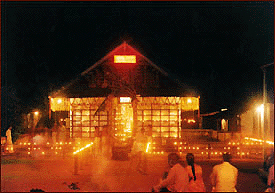
Viswambhara Temple As described in Srila Prabhupada's purport to Caitanya-caritamrta Madhya 20:244, Dattatreya is considered the eighth out of 25 lila-avatars. Srimad Bhagavatam 1:3:1-28 also lists 22 main incarnations of the Lord (outside of the Dasavatar), and this list includes Dattatreya. Because the lila-avataras appear in each day of Brahma, (each kalpa, or millennium), they are also referred to as kalpa-avataras. Srimad Bhagavatam describes Dattatreya in this way: "The sixth incarnation of the purusa was the son of the sage Atri. He was born from the womb of Anasuya, who prayed for an incarnation. He spoke on the subject of transcendence to Alarka, Prahlada and others [Yadu, Haihaya, etc.]."
Lord Dattatreya is considered by many to actually be an incarnation of the Trimurti: Brahma, Vishnu and Siva. The word 'Datta' means "given". Datta is so called because the divine trinity have "given" themselves in the form of a son to the sage couple Atri and Anasuya. He is the son of Atri, hence the name "Atreya."
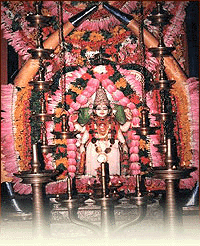
Lord Viswambhara at Arya Vaidya Sala Dattatreya is typically depicted with three heads, symbolising Brahma, Visnu, and Shiva; past, present, and future; and the three states of consciousness: waking, dreaming, and dreamless sleep. He is often portrayed sitting in meditation with his shakti beneath the audumbara (wish-fulfilling) tree. The ancient system of Ayurveda medicine can be dated by extant evidence to the Vedic period, about 5,000 years ago. But in fact, Lord Brahma, the Creator is said to be the originator of this system. From Brahma it was passed on to the Rishis through Indra, who passed it down in disciplic succession. Disciples in this line of succession accept Lord Viswambhara as the ninth avatar in succession from Lord Dattatreya, thus the importance of the deity installed at Arya Vaidya Sala. Having established this connection between Lord Brahma, through Dattatreya and the establishment of Ayurveda, we can see that it's possible that references to a Brahma temple in Kottakkal could possible be referring to the Viswambhara deity at the Arya Vaidya Sala center.
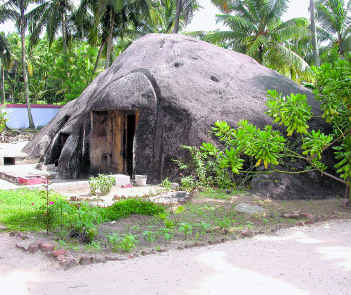
Lord Viswambhara at Arya Vaidya Sala Aside from the Viswambhara temple, other temples of note in the area include the Kadampuzha Devi temple, and the Venkata Tevar Siva Temple, a well known rock-cut temple in Ponmala, halfway between Kottakal and Malapuram. Constructed in the 7th-8th centuries A.D., the architecture here is believed to be Dravidian, influenced by Pallava art. There are five small temples cut into the face of a huge rock. The inside walls of the temples have various mural paintings, now deteriorating, and several murtis reside here. While this is a functioning temple, we have not discovered a Brahma deity housed here. We make mention of it here because it is often mistakenly referred to as being the temple associated with Arya Vaidya Sala.
Finally, among the local Kottakkal temples with some relationship to Lord Brahma, but likely not the one referred to as a dedicated Brahma temple, we should mention the Sree Ramaswamy Temple in Ramapuram, Malapuram. Sreerama Temple is located 32 km. east of Kottakkal, and 9 km. southeast of Malapuram. As the name indicates, it is a temple primarily dedicated to Lord Ramacandra.
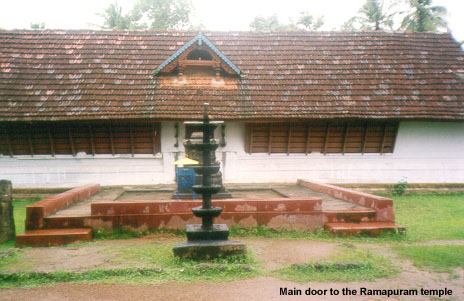
Sree Ramaswamy Temple Like Lord Brahma, temples in this part of India dedicated to Sri Rama are also quite unusual. The history of this temple and the installation of the deity is fascinating. A north Indian Brahmin was carrying his Ishta devatha deity with him while going on Thirtha yathra. The deity is one he had acquired in Nepal. On the way, he passed by Ramapuram, stopping at a local residence only to find that all the male members had gone to the nearby temple for Varam, a feast for the brahmans. Leaving his deity at the home, he instructed the women in the house that under no circumstances should they give any Naivedyam (bhoga offerings) to the Deity. He then left for the nearby temple. The young Namboodri girls in the house, being very mischievous, offered palpayasam, a milk preparation to the deity. When the pilgrim returned, he found that the idol had become stuck to the floor, and could not be moved. Having no alternative, he left the Deity there and proceeded on his yatra. Being very upset at having to leave without his Ishtadevatha, however, he accidentally fell from a stone bridge and died there. The local residents built a Sree Rama temple near that spot, in an area covered with thick shrubs. A mirror was installed in a corner of the temple to honour the memory of the departed brahman, and because of his accidental death, the deity there is known as a Brahma Rakshas. So while this is not a temple dedicated to the worship of Lord Brahma the creator, we can see how there might be confusion on the point. The Upadevatha, or secondary deity at this temple is Sastha, a married god with two wives. The term "Sastha" generally refers to one "created by Brahma".
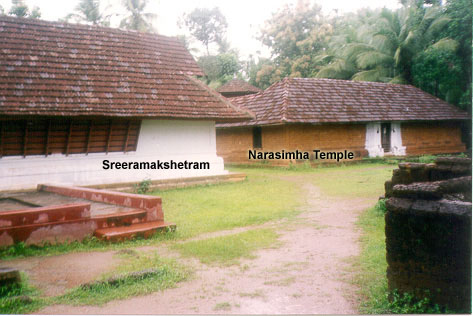
Sree Ramaswamy Temple This Ramapuram Sreerama Swamy Temple is one of four temples in central Kerala that devotees throng to during the holy month of Karkitakam. All four temples are located in the area around Ramapuram, within a distance of three kilometres. They are Ramapuram Sree Ramaswamy Temple, Koodappulam Sree Lakshmanaswamy Temple, Amanakara Sree Bharathaswamy Temple, and Methiri Sree Sathrughnaswamy Temple. These temples together are called the Nalambalam. Between the four temples, the deities here are the four sons of King Dasaratha: Lord Ram, Bharata, Lakshmana, and Satrughna. There is also a temple to Sita Devi. It is said that in all of the local Hindu homes, at least one child is named Rama. In tomorrow's segment, we will visit the Thirunavaya Brahma Temple. Although located 27 km. south of Kottakkal, this temple may well be the one most often referred to as the Kodakkal, Malabar Brahma temple.
| |
